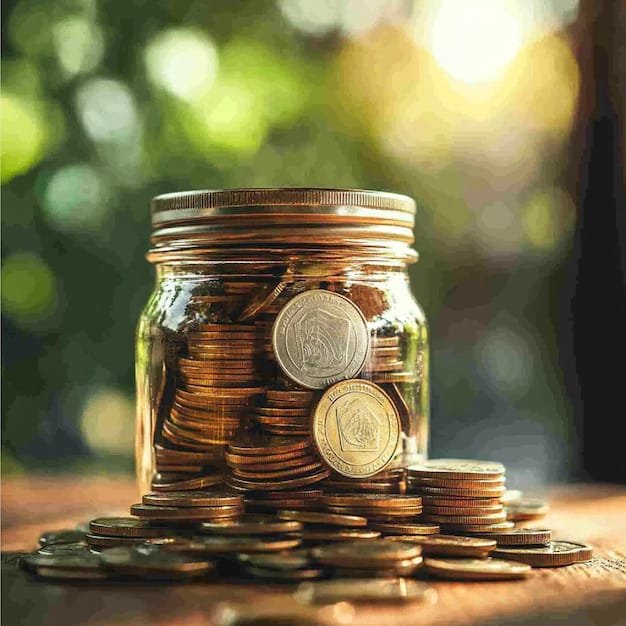Financial Planning: Building an Emergency Fund for Unexpected Expenses

Financial planning for unexpected expenses involves creating and maintaining an emergency fund to cover unforeseen costs like medical bills, job loss, or car repairs, ensuring financial stability and peace of mind.
Life is full of surprises, and not all of them are pleasant. From sudden medical bills to urgent home repairs, unexpected expenses can throw even the most carefully planned budget into disarray. That’s why financial planning for unexpected expenses: building an emergency fund is not just a good idea, it’s a crucial foundation for financial security and peace of mind.
Understanding the Importance of Emergency Funds
An emergency fund is a dedicated savings account specifically for unplanned, urgent expenses. It’s your financial safety net, providing a cushion to absorb financial shocks without resorting to debt or disrupting long-term savings goals. Let’s delve into why having this fund is essential for effective financial planning.
The Psychological Benefits of an Emergency Fund
Beyond the purely financial, an emergency fund offers significant psychological benefits. Knowing you have funds available to handle unforeseen issues can reduce stress and anxiety about money. It provides a sense of control and security, allowing you to approach life’s uncertainties with greater confidence.
Avoiding Debt with an Emergency Fund
One of the most significant advantages of an emergency fund is its ability to prevent you from accumulating debt. Without emergency savings, many people resort to credit cards or loans to cover unexpected costs. These options often come with high interest rates, making it difficult to repay the debt and potentially leading to a cycle of financial distress.

An emergency fund enables you to handle these situations using your savings, avoiding the burden of additional debt and the associated interest charges. This can save you a considerable amount of money in the long run and keep your financial goals on track.
An emergency fund is more than just a financial tool; it’s a foundation for stability and peace of mind. It helps alleviate stress, prevents debt accumulation, and provides the financial flexibility to navigate life’s unexpected turns, securing your financial future.
Assessing Your Emergency Fund Needs
Determining the right size for your emergency fund is a critical step in financial planning. The ideal amount varies depending on individual circumstances, such as job security, monthly expenses, and potential risks. Let’s explore how to evaluate your specific needs to create an adequate safety net.
Calculating Your Monthly Expenses
Begin by calculating your essential monthly expenses. This includes rent or mortgage payments, utilities, groceries, transportation, insurance, and any other costs necessary for your basic survival. Be realistic and comprehensive in your assessment, ensuring you capture the true cost of maintaining your current lifestyle.
Once you have a clear figure for your monthly expenses, consider how many months you would like your emergency fund to cover. A commonly recommended target is 3-6 months of living expenses. However, those in less stable industries or with higher financial risk might prefer to save even more. The right amount is one that gives you peace of mind and adequate time to address potential financial setbacks.
Evaluating Job Security and Potential Risks
Your job security and the potential risks you face can significantly impact the size of your emergency fund. If you work in a stable industry with high demand and have a reliable employment history, you may be comfortable with a smaller fund. However, if you work in a volatile industry or have significant financial dependents, a larger fund can provide greater security.
- Job Security: Assess the stability of your current job and industry trends.
- Potential Risks: Consider potential risks such as medical issues, home repairs, or car breakdowns.
- Financial Dependents: Increase your fund if you have dependents who rely on your income.
- Insurance Coverage: Evaluate your insurance policies to determine what expenses are already covered.
By thoroughly assessing your monthly expenses, job security, and potential risks, you can determine the appropriate amount for your emergency fund. This personalized approach ensures that your financial safety net is adequate to meet your specific needs and circumstances.
Strategies for Building Your Emergency Fund
Building an emergency fund can seem daunting, but with the right strategies, it’s an achievable goal. Developing a budget, setting realistic savings goals, and automating your savings are effective ways to steadily grow your fund. Let’s explore these strategies in detail.
Creating a Realistic Budget
A budget is the foundation of any successful savings plan. Start by tracking your income and expenses to understand where your money is going each month. Identify areas where you can cut back spending, such as dining out, entertainment, or unnecessary subscriptions. Use budgeting apps, spreadsheets, or traditional pen and paper to monitor your finances effectively.
Setting Achievable Savings Goals
Break down your emergency fund goal into smaller, manageable steps. Instead of focusing on the total amount you need to save, set weekly or monthly savings targets. This approach makes the process feel less overwhelming and helps you stay motivated. Celebrate milestones as you reach them to reinforce your progress and maintain momentum.
Automating Your Savings
Automation is a powerful tool for building your emergency fund. Set up automatic transfers from your checking account to your savings account each payday. This “pay yourself first” strategy ensures that you consistently contribute to your fund without having to actively think about it. Many banks offer features that make automating savings easy and convenient.

Building your emergency fund doesn’t happen overnight, but by creating a realistic budget, setting achievable savings goals, and automating your savings, you can steadily work towards your financial security. Consistency and discipline are key to success, turning a seemingly large goal into a reality.
Where to Keep Your Emergency Fund
Choosing the right place to keep your emergency fund is essential for ensuring it is both accessible and secure. High-yield savings accounts, money market accounts, and certificates of deposit (CDs) are popular options. Let’s compare these options to help you make an informed decision.
High-Yield Savings Accounts
High-yield savings accounts (HYSAs) are a popular choice for emergency funds due to their accessibility and higher interest rates compared to traditional savings accounts. These accounts are typically offered by online banks and credit unions, providing a safe and convenient way to grow your savings. The higher interest rates help your money earn more over time, offsetting inflation and maximizing your savings potential.
Money Market Accounts
Money market accounts (MMAs) are another option for storing your emergency fund. These accounts offer features similar to savings accounts, but often come with higher interest rates and check-writing capabilities. MMAs are a good choice if you want slightly better returns than a savings account while still maintaining easy access to your funds. Compared to HYSAs, MMAs may require higher minimum balances or have tiered interest rates.
Both high-yield savings accounts and money market accounts offer attractive interest rates and easy access to your funds, making them ideal for emergency savings. Shop around to compare rates and fees to find the best option for your needs, ensuring your emergency fund grows steadily and remains readily available.
Maintaining and Replenishing Your Emergency Fund
Building an emergency fund is just the beginning; maintaining and replenishing it is crucial for long-term financial security. Regularly reviewing your fund’s balance and having a plan for replenishment after withdrawals are essential practices. Let’s explore how to keep your emergency fund in top shape.
Regularly Reviewing Your Fund’s Balance
Make it a habit to regularly review your emergency fund’s balance. This ensures that it still aligns with your current expenses and financial situation. As your income, lifestyle, or job security changes, adjust your savings goals accordingly. Aim to review your fund at least quarterly, or more frequently if you experience significant life changes.
Replenishing Your Fund After Withdrawals
Having a plan for replenishing your emergency fund after withdrawals is vital. Treat any withdrawal from your emergency fund as a temporary loan that needs to be repaid promptly. Adjust your budget to allocate additional funds towards replenishing your savings. Consider temporarily cutting back on non-essential expenses or increasing your income through side hustles to accelerate the process.
- Adjust Your Budget: Allocate additional funds towards savings.
- Cut Back on Non-Essentials: Temporarily reduce non-essential spending.
- Increase Income: Consider side hustles or overtime work.
Maintaining and replenishing your emergency fund is an ongoing commitment to your financial well-being. Regularly review your balance, have a clear plan for replenishment, and stay disciplined in your savings habits to ensure your financial safety net remains strong and reliable.
Integrating Your Emergency Fund into Overall Financial Planning
An emergency fund is a vital component of a comprehensive financial plan. It works in tandem with other financial strategies, such as debt management, retirement planning, and investment goals. Let’s discuss how to integrate your emergency fund into your broader financial strategy for maximum impact.
Prioritizing Your Emergency Fund
When developing your financial plan, prioritize building your emergency fund before focusing heavily on other goals like investing or paying down debt (excluding high-interest debt). A well-funded emergency account provides a safety net that prevents you from derailing your long-term financial objectives. By addressing potential financial emergencies upfront, you create a more stable foundation for all your financial endeavors.
Coordinating with Other Financial Goals
Once you have a solid emergency fund in place, coordinate it with your other financial goals. This involves allocating resources strategically between debt repayment, investing, and retirement savings. Ensure that your emergency fund remains adequately funded even as you pursue these other objectives. Regularly reassess your priorities to maintain a balanced and effective financial strategy.
Integrating your emergency fund into your overall financial plan requires careful prioritization and coordination with other financial goals. By focusing on building a solid safety net first, and then strategically allocating resources, you can achieve comprehensive financial security and peace of mind. A well-integrated approach ensures that your short-term and long-term financial objectives work together harmoniously.
| Key Point | Brief Description |
|---|---|
| 💰 Importance of Emergency Fund | Provides financial security and reduces stress during unexpected events. |
| 📊 Assessing Emergency Fund Needs | Calculate monthly expenses and evaluate job security to determine the ideal fund size. |
| 🏦 Strategies for Building | Create a budget, set savings goals, and automate savings to build the fund efficiently. |
| 🔄 Maintaining and Replenishing | Regularly review the balance and replenish after withdrawals to keep the fund healthy. |
Frequently Asked Questions (FAQ)
A commonly recommended target is 3-6 months of essential living expenses. Evaluate your job security and potential risks to determine the right amount for you.
High-yield savings accounts and money market accounts are excellent choices. They offer easy access to your funds while earning a higher interest rate than traditional savings accounts.
Treat any withdrawal as a temporary loan and prioritize replenishing the fund as quickly as possible. Adjust your budget to allocate extra funds towards savings.
Aim to review your fund’s balance at least quarterly, or more frequently if you experience significant life changes, to ensure it still meets your needs.
It’s generally not recommended to use your emergency fund for investments, as these funds should remain readily available for true emergencies, without risk of loss.
Conclusion
Building an emergency fund is a critical step towards achieving financial security and stability. By understanding its importance, assessing your individual needs, implementing effective savings strategies, and integrating it into your overall financial plan, you can create a robust safety net that protects you from life’s unexpected financial challenges.





